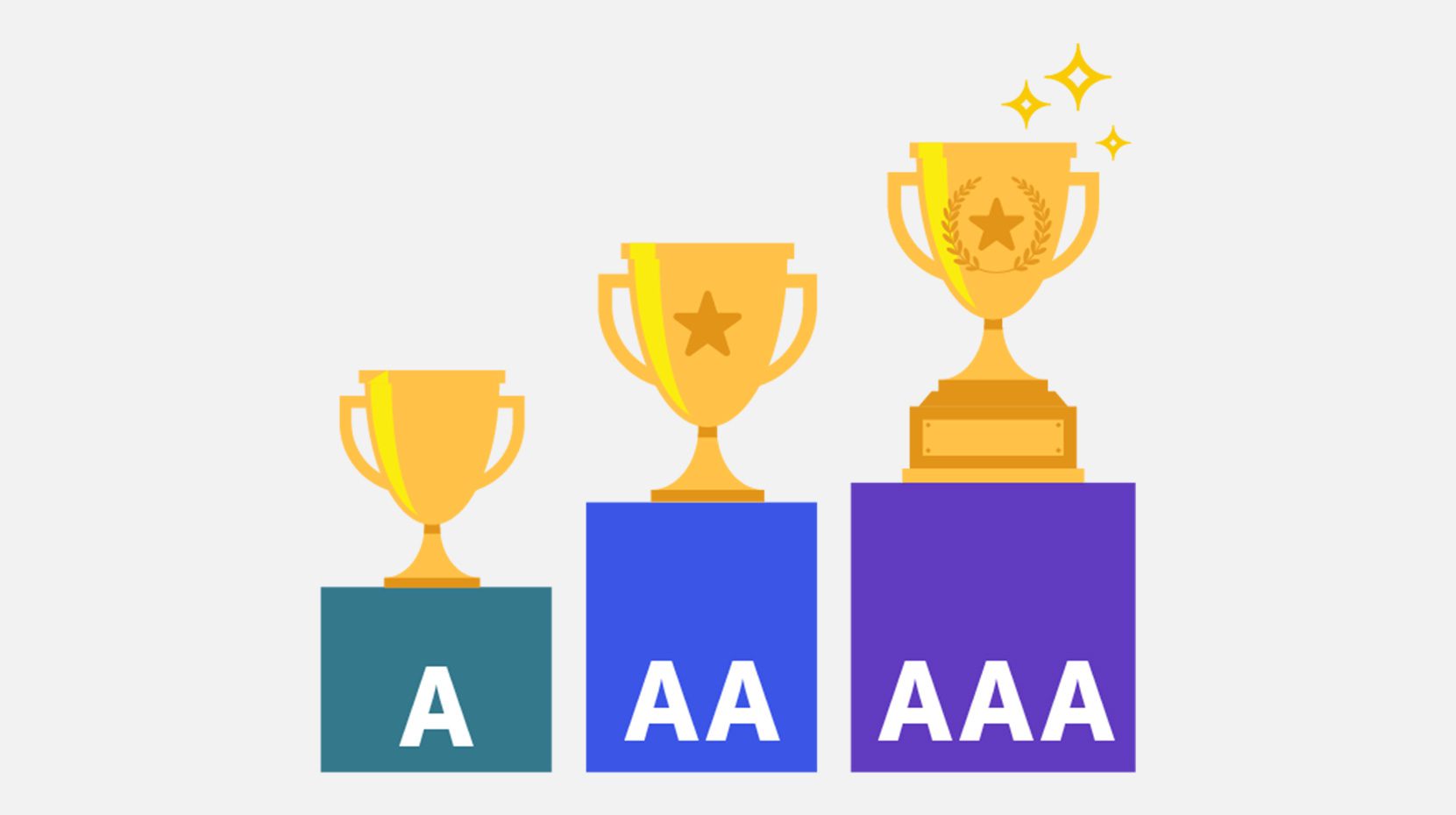Evaluating your websites accessibility
As digital accessibility uptake increases within the business world it’s crucial that you familiarise yourself with the various levels of compliance set out within the WCAG guidelines; there are three different levels, those being:
Level A: This is the minimal, or lowest level of compliance. Rather than highlighting elements that would make your website more accessible this level of conformance essentially surfaces elements that can make a website inaccessible.
Notable WCAG level A requirements include no keyboard traps, navigable with a keyboard only, non-text content alternatives, video captions, and no meaning conveyed solely through things like shape, size, or colour alone.
Level AA: This is the acceptable level of compliance; this means that your website is deemed usable and understandable for the majority of individuals with or without disabilities.
Notable WCAG level AA requirements include colour contrast is at least 4.5:1, alt text is used for images that convey a meaning, consistent navigation throughout your site, accurate and descriptive form field labels, and headings are used in a logical order.
Level AAA: This is the optimal level of compliance; this means that your site is deemed accessible to the maximum number of users and makes their experience easy. It is worth noting that this level of compliance is generally not recommended as it is not always possible to meet all AAA criteria for some content types. If your website specifically caters to the elderly or those with disabilities then it would be worth working to reach this level of compliance, otherwise it’s advisable that you do all you can to reach the upper echelons without jeopardising your user experience for others.
Notable WCAG level AAA requirements include sign language interpretation for audio or video content, colour contrast of at least 7:1, context sensitive help is available, and timing is not an essential part of any activity.
For full details on WCAG conformance levels visit:
https://www.w3.org/TR/UNDERSTANDING-WCAG20/conformance

Testing accessibility
Now that you understand the different levels of accessibility it’s time to think about checking and improving your accessibility. When starting out this can feel overwhelming but stay the course and seeking to incorporate it as part of your standard development process will pay off. Often to ensure that your website is compliant with accessibility standard you require some level of guidance or input from experts, however, there are easy checks that anybody can carry out to attain a baseline performance of your website and discover where you fit into their standards. In doing this you can avoid extra cost outsourcing work and make some accessibility changes yourself.
So where do you start?
When discussing accessibility testing it is commonly accepted that there is a three-tiered approach that you can use to sculpt your approach:
- Tier 1: Automated testing
- Tier 2: Automated and manual checks
- Tier 3: User testing with individuals from the disabled community
Tier 1: Automated Testing
Tier 2: Automated and manual checks
Manual checks
Technology is constantly improving but even today automated testing cannot mimic every human interaction. It is therefore widely accepted that to be fully compliant manual testing is unavoidable important. To put this into context automated testing will fail when it comes to checking things like:
- Enlarging text
- Keyboard-only navigation
- Responsiveness of content
- Screen reader compatibility
- Adapting colours
- Accessing and navigating all menus
Typically, this is because the check is an inference made by a person.
Looking more closely at the first 3 scenarios listed above in more detail it is reasonably obvious why a manual check is needed:
Enlarging text size – You would do this to verify that there is no loss of content, and manually verify that relevant information is still close enough together to give context. Subjective nature of the check requires human validation.
Navigable by keyboard only – This can be tested very simply by selecting the web address bar, you then want to take your hand off the mouse and begin to tab around your site, you do this to check that the order of selection is structured in an intuitive and logical manner, while using shift + tab to navigate backwards, and the spacebar to activate checkboxes and buttons where applicable. The logical flow of the check requires human validation.
Responsive design and content scaling – This check would be carried out to ensure that there is no loss of function or content on smaller screens of phones, laptops, or tablets. This type of testing can be verified on desktop by expanding and shrinking the size of the browser windows to simulate different sized monitors. Subjective nature of the check requires human validation.
In each of the scenarios listed out automated testing tools would fail to adequately recreate the context to ascertain if the experience is logical, clear and/or intuitive.
When to use automated testing when also manually auditing:
Broadly speaking anything programmatic should be suitable for automated testing. In a practical sense we recommend dovetailing manual checks with automated to make sure nothing was missed by human error.
Choosing the right tool for the job is entirely preferential, the most used tools are WAVE, JAWS Inspect, and Dynomapper. To discover more tools that you can use visit the Web Accessibility site here: https://www.w3.org/WAI/ER/tools/
Tier 3: Disabled User Testing
Stage three of accessibility evaluations should always include testing with real members of the disabled community; it is common to outsource this part of the work due to the complex nature of testing and obtaining results that are true to their cause. While using a professional agency or individual comes with costs involved there is no better way to ensure that the research is carried out with experience and professionalism.
Disabled user testing will aim to resolve key questions such as:
- How does my product/service perform with assistive technologies?
- Do disabled users enjoy using my product or service?
- How much effort is required to get the ideal state?
- What opportunities are there for me to innovate?
- How are market leaders solving similar problems for their customers with access needs?
- What opportunities are there for my product/service to lead the market in terms of accessibility?
Visiting an empathy lab, such as REO’s own (empathy lab) in London can also be a good way to help foster the right attitude to inclusive design and accessibility within your organisation. User testing is incredibly powerful, and it will quickly become clear the effectivity of working from the insights gained. You should aim to have adequate sample sizes for the most common impairments:
- Auditory
- Speech
- Visual
- Physical
- Neurological
You can find out more about each of these in our earlier blog: Accessibility barriers ahead
In closing
By ensuring your website or app offers a fair experience for your customers with disabilities you mitigate the risk of lawsuits, increase overall compliance levels, and improve awareness within your teams around the experience of individuals with disabilities.
Of course, addressing accessibility at first may seem like a lot of work, but once you do breakthrough the learning curve it will quickly become part of your standard development processes. By testing early and often you save time in the long run while simultaneously implementing accessibility at all levels, like a culture of experimentation, implementing accessibility into everything you do will always return greater all-round results.












